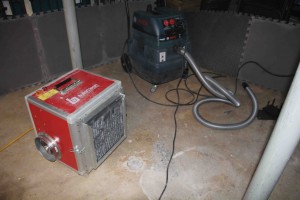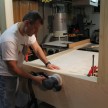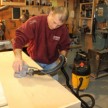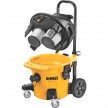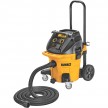Dust Extraction
Controlling Dust At The Job Site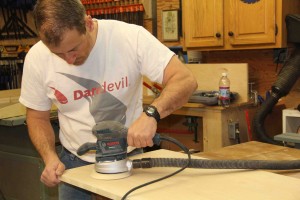
A good dust control strategy is essential to being a professional contractor and keeping your customer happy throughout a construction project.
I’ve learned early on that learning how to control remodeling dust by keeping it out of the air and non-remodeled portion of your clients home is often more important than the quality of your work.
There is nothing worse than having to spend an hour or more cleaning the job site after a sanding, cutting or drilling application created airborne dust. Worse yet is to have to pay for a professional to clean the site because the airborne dust you created stetted everywhere in the house.
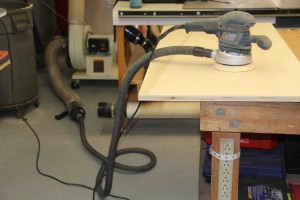
Dust inhalation can cause occupational asthma, silicosis, cancer and other debilitating respiratory diseases. When cutting masonry and concrete, it is vital to take precautions to protect yourself against the silica in those products.
I’ve written several articles on best practices to control remodeling dust. One of those practices is to capture dust at the source using dust extractor vacuums. This means using a quality tool activated HEPA vacuum to suck up the dust at the source, as it is created.
You can accomplish this two ways:
- Have a helper hold a HEPA vacuum at the tool making the dust, or;
- Use a tool activated vacuum and a dust extractor hood that attaches to the tool and captures the dust during the cutting or drilling application.
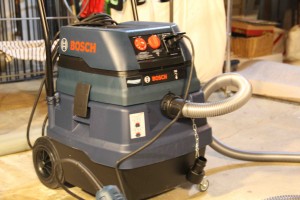
Dust Extraction At The Job Site
Dust control and dust extraction shouldn’t be an afterthought and should be incorporated into your operations to maximize your work along many dust-controlling practices.
If you take the time to tool up properly and set up your construction site for dust extraction and control you will enjoy the following benefits:
- Save time and money with your clean up time,
- Increase your production and efficiency
- Improve your work site air quality, less air pollution
- Professional approach to your work, impress your customers.
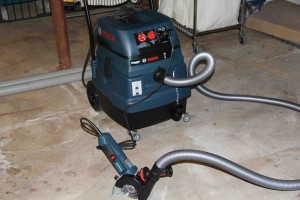
- A clean and safe working environment
- Compliance with laws and regulations
- Improved quality of the finished product
Happy customers become loyal, pay their bills and refer you to other customer.
Capture Dust At The Source
Regardless of whether you’re working in the shop or on a jobsite, a good dust extraction system should start with capturing and removing dust at the source.
Removing airborne dust by capturing it at the source means using a high efficiency vacuum and dust collecting attachments to collect the dust at the blade, sanding pad or drill bit.
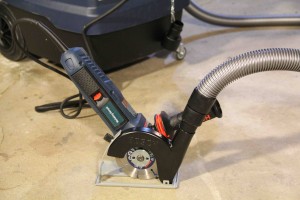
Dust Extraction Saves Time And Money
Having a safer, cleaner air environment and less settled dust to cleanup are two things that you and your customers can appreciate. Dust collection practices will separate you from your competition but presenting a complete and professional approach to your dust collection and containment. Another thing to consider is that EPA regulations are moving in the direction of requiring contractors use a HEPA dust containment system.
EPA HEPA Vac requirements
- Constructed so that 100% of the airflow passes through the filters.
- HEPA filters that capture 99.97% of all particles of .3 microns or larger.
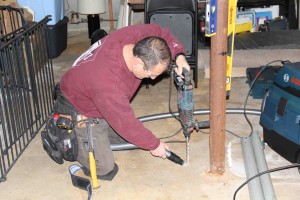
I use a Bosch Airsweep, model 3931A-PB is a 13 Gallon Wet/Dry Vacuum Cleaner equipped with a HEPA filter on my jobsites. My Bosch HEPA filters exceed the EPA requirement and capture 99.99% of particles that size. (VAC019)
Less Wear And Tear On Tools
Good dust extraction extends the life of your tools by reducing motor heat resulting in dust-induced tool failure.
Purchase Dust Extraction Technology
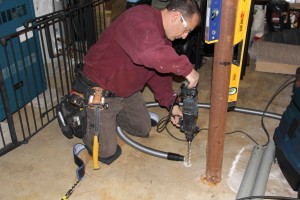
If you are buying new machines or power tools, look for products that have built in vacuum hoods and ports, which will make your dust collection more effective. For me this means using a tool-activated vacuum with 99.99% filtration efficiency.
Tool activation refers to a built in vacuum feature that allows power tools to plug into the vacuum and remotely turn the vacuum “on and off” with tool activation. My Bosch Airsweep VAC offers “Activation by Power Tool” Mode, a similar feature. Tool activated vacuums will run for a few seconds after the tool is turned off, to clear the hose of dust.
Another feature that my Bosch Airsweep has which I like is Pulse-Clean™ electromagnetic filter cleaning system that is only activated by the vacuum when needed and helps to maintain maximum suction power. This system blows air out of the filters to keep fine particulate dust from covering the HEPA filter and reducing efficiency.
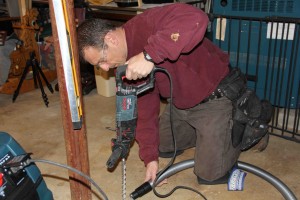
Do Your Homework
Take the time to research and then purchase a vacuum cleaner that is designed for collecting concrete dust, masonry, plaster, wood and other material. Applications for this vacuum should include:
- Concrete grinders, 5″ with dust evacuation guards
- Tuck point grinders with dust evacuation guards
- Masonry saws with dust evacuation guards
- Sanders, Planers, drills and miter saws
Dealing With Existing Older Tools
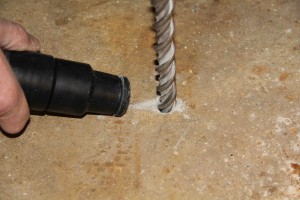
Many of my job site tools like my random orbital sander; belt sander, miter saw and planer all have dust bags. These dust bags work ok but are ineffective at collecting and controlling air borne dust. Attaching a vacuum hose to these ports significantly improves the efficiency of the dust collected.
Adding suction to these exhaust hoods or ports creates a dust capture velocity and effectively that grabs and pulls the dust particles away from the cutting or sanding action and into a filtered vacuum canister. Some tools, like plaster sanding and concrete cutting create so much airborne dust that specific hoods should be attached to the tool to create a better more efficient way to trap and collect the dust.
Dust Collecting Accessories
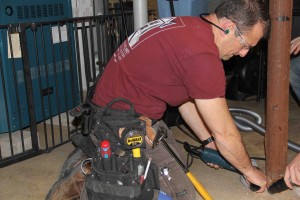
Purchase accessories that fit your tool and are equipped with vacuum ports and hoods on the guards for dust extraction and vacuum hose attachment.
Useful Dust Extractor Features
1. Operation Modes:
Many high quality vacuums offer different modes of operation. This gives you the most vacuuming versatility on the job site and allows you to choose from regular vacuum, power tool activation, and filter cleaning operation.
2. Auto Filter Cleaning:
Filter cleaning is a new feature that many high quality vacuums now have. A built in features blows air through the filter to keep fine particulate from accumulating on the high efficiency filter which maintains your vacuums suction power.
3. Power Broker Control:
Look for a Power Broker™ feature. Power Broker is a Bosch feature that I have on my Bosch Airsweep, model 3931A-PB is a 13 Gallon Wet/Dry Vacuum Cleaner.
The power broker feature allocates electric power (15 amps on a 15 amp circuit, 20 amps on a 20 amp circuit) between vacuum cleaner and connected power tool to optimize usage of the available power and avoid blown circuits. Also allows suction control for other purposes as well.
4. Elevated Filter Location:
This feature places the vacuum filters above the maximum dust or water accumulation height to help maintain maximum airflow and suction power.
5. High Capacity Filter:
Fine dust filtration capabilities that captures 99.93% particles of 3.0 microns and larger in diameter is important to capture that fine plaster and concrete dust.
6. Low Amp Motor:
Look for a motor that won’t trip the electrical service breakers when you turn on the tool or run it with other tools. My Airsweep has an 11.1-Amp motor with soft-start and bypass cooling.



